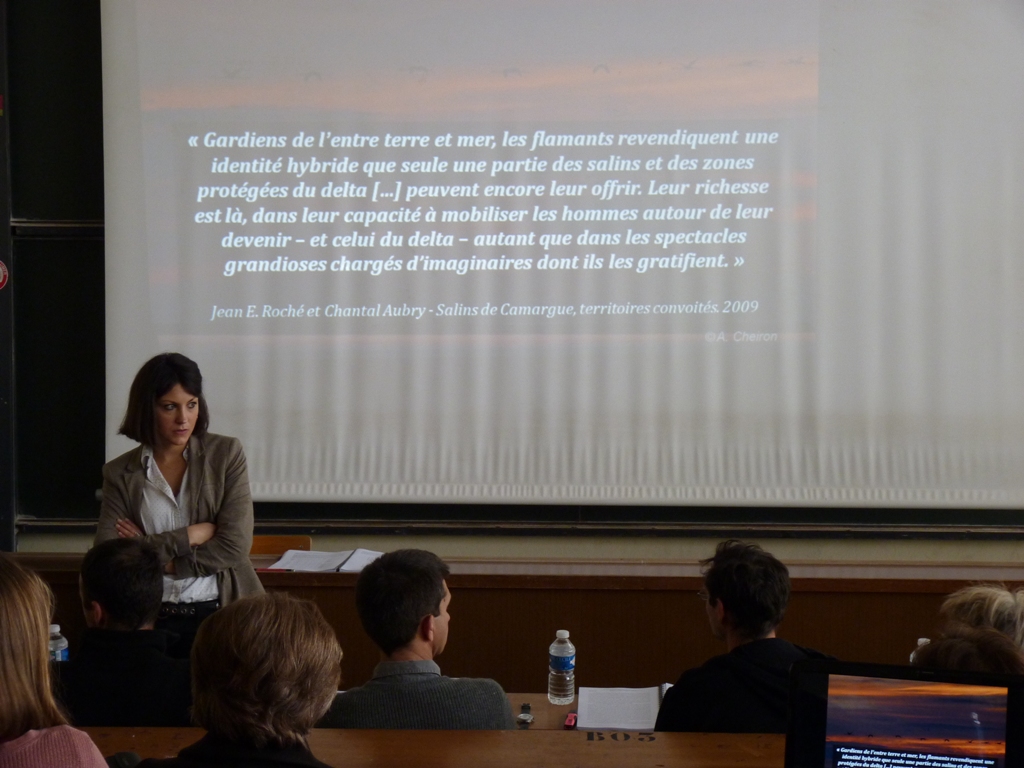The end of 2013 at the Tour du Valat is turning out to be particularly rich in terms of university research projects, with the defence of three doctoral theses by PhD students, who have been carrying out research on the site since late 2010.
First of all, on 6 December in the Tour du Valat conference room, Isabelle Muller of the “Sciences and Agro-sciences” doctoral college of the University of Avignon and the Vaucluse defended her thesis on the “Temporary wetland and mesoxeric grassland restoration of former ricefields: Respective role of filters in community assembly“. The large audience included the many partners with whom she has worked in the Camargue during the last three years. Prepared jointly at the Mediterranean Biodiversity and Ecology Institute (IMBE) and the Tour du Valat, Isabelle’s thesis consisted in studying the initial results of an ecological engineering project at le Cassaïre in terms of the restoration of plant communities. The aim is to transform former rice fields into temporary marshes for conservation and hunting purposes. The project is located on land belonging to the Conservatoire du Littoral (French coastal protection agency), managed by the association Les Amis des marais du Vigueirat. We should note that this project, which combines ecological, socio-economic and cultural dimensions, is considered by the CNRS (French National Center for Science and Research) to be of major importance, because it could potentially provide a real model for the ecological restoration of other degraded natural sites in the Mediterranean basin.
 Anne-Sophie Deville defended her thesis on 13 December at Montpellier 2 University (Sciences and Technologies). Anne-Sophie arrived at the Tour du Valat in autumn 2010, and her research subject was “Energetic needs and spatial distribution of the Greater Flamingo (Phoenicopterus roseus), salt pans reconversion consequences for the conservation of the species.” Anne-Sophie endeavoured to study the potential impacts of the restoration of the Salin-de-Giraud former saltworks area on the Greater Flamingo, an emblematic species in the Camargue. The project was initiated and financed (by a special inter-ministry research fund and the PACA Region) in the framework of a research project (SALINALGUE) into the development of micro-alga cultivation in former saltworks. The subject of her thesis is also highly relevant in the context of the purchase in 2008 of half the Salin-de-Giraud saltworks area by the Conservatoire du littoral, the main immediate consequence of which is a considerable change in water management practices. This research project is of crucial importance in the current context of profound changes to the salt industry in the Camargue, and more broadly speaking across the Mediterranean basin. Since the second half of the 19th century, the salt industry has deeply affected the culture, economy, landscapes, and local biodiversity of the Camargue, most notably by creating and maintaining for several decades habitats favourable to the only breeding flamingo colony in France.
Anne-Sophie Deville defended her thesis on 13 December at Montpellier 2 University (Sciences and Technologies). Anne-Sophie arrived at the Tour du Valat in autumn 2010, and her research subject was “Energetic needs and spatial distribution of the Greater Flamingo (Phoenicopterus roseus), salt pans reconversion consequences for the conservation of the species.” Anne-Sophie endeavoured to study the potential impacts of the restoration of the Salin-de-Giraud former saltworks area on the Greater Flamingo, an emblematic species in the Camargue. The project was initiated and financed (by a special inter-ministry research fund and the PACA Region) in the framework of a research project (SALINALGUE) into the development of micro-alga cultivation in former saltworks. The subject of her thesis is also highly relevant in the context of the purchase in 2008 of half the Salin-de-Giraud saltworks area by the Conservatoire du littoral, the main immediate consequence of which is a considerable change in water management practices. This research project is of crucial importance in the current context of profound changes to the salt industry in the Camargue, and more broadly speaking across the Mediterranean basin. Since the second half of the 19th century, the salt industry has deeply affected the culture, economy, landscapes, and local biodiversity of the Camargue, most notably by creating and maintaining for several decades habitats favourable to the only breeding flamingo colony in France.
Finally, Sébastien Ficheux, who has been doing his research at the Tour du Valat since early 2011, will defend his doctoral thesis on 20 December at the University of Burgundy (co-supervising university) in Dijon, on the subject “Population dynamics and genetics of European Pond Turtle (Emys orbicularis)“. This turtle species is threatened by catching practices and the degradation of natural habitats that has taken place since the 19th century, together with the more recent introduction of competitive exotic species, such as the Red-eared Slider (Trachemys scripta elegans). In this context, it is essential to understand how the increasing fragmentation of their habitat could influence the connectivity of terrapin populations, and ultimately impact their dynamics and genetic structure. During the last three years, Sébastien has been able to benefit from an ideal working environment and large quantities of data, because since 1997 the Tour du Valat has been involved in a long-term monitoring project, virtually unique in France, of terrapin populations in the Camargue, in particular via annual capture-mark-recapture (CMR) programmes. Once again an essential research project, for enhancing our knowledge of one of the most threatened reptile species in Europe and actively participating in the conservation of its relict populations.
You can access abstracts of these three theses via the links on the right, and full electronic versions already are or will be made available as soon as possible on the Tour du Valat website (see “Current publications“).